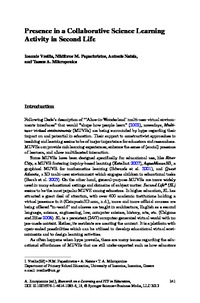Presence in a Collaborative Science Learning Activity in Second LifeIoannis Vrellis, Nikiforos M. Papachristos, Antonis Natsis, Tassos A. Mikropoulos
Zu finden in: Research on e-Learning and ICT in Education (Seite 241 bis 251), 2012
 |
 |
 Diese Seite wurde seit 4 Jahren inhaltlich nicht mehr aktualisiert.
Unter Umständen ist sie nicht mehr aktuell.
Diese Seite wurde seit 4 Jahren inhaltlich nicht mehr aktualisiert.
Unter Umständen ist sie nicht mehr aktuell.
 Zusammenfassungen
Zusammenfassungen
 Multi-user virtual environments (MUVEs) are surrounded by hype regarding their impact on and potential in education. Many issues regarding the educational affordances of MUVEs and the learning experience of users are still under research. Presence is an important phenomenon users experience when interacting with and via virtual environments and seems to play an important role in learning. This chapter presents empirical data gathered from an exploratory study regarding a problem-based physics learning activity in Second Life (SL). Our aim is to gain knowledge and experience about the sense of presence (spatial and social) that emerges while students collaborate in MUVEs. Students (n = 30) collaborated 'in-world' to solve a problem. Data were gathered using the Temple Presence Inventory questionnaire. Results indicate higher scores of social presence than spatial presence. Correlations were found between dimensions of presence, subjective computer expertise, and tendency to become involved in activities.
Multi-user virtual environments (MUVEs) are surrounded by hype regarding their impact on and potential in education. Many issues regarding the educational affordances of MUVEs and the learning experience of users are still under research. Presence is an important phenomenon users experience when interacting with and via virtual environments and seems to play an important role in learning. This chapter presents empirical data gathered from an exploratory study regarding a problem-based physics learning activity in Second Life (SL). Our aim is to gain knowledge and experience about the sense of presence (spatial and social) that emerges while students collaborate in MUVEs. Students (n = 30) collaborated 'in-world' to solve a problem. Data were gathered using the Temple Presence Inventory questionnaire. Results indicate higher scores of social presence than spatial presence. Correlations were found between dimensions of presence, subjective computer expertise, and tendency to become involved in activities. Dieses Konferenz-Paper erwähnt ...
Dieses Konferenz-Paper erwähnt ...
 Begriffe KB IB clear |  Affordance Affordance Affordance
, Affordance
,  Lernen Lernen learning
, Second lifeSecond life
, Second Life in EducationSecond Life in Education learning
, Second lifeSecond life
, Second Life in EducationSecond Life in Education
|
 Tagcloud
Tagcloud
 Anderswo finden
Anderswo finden
 Volltext dieses Dokuments
Volltext dieses Dokuments
 |  Presence in a Collaborative Science Learning Activity in Second Life: Artikel als Volltext bei Springerlink ( Presence in a Collaborative Science Learning Activity in Second Life: Artikel als Volltext bei Springerlink ( : :  , 304 kByte; , 304 kByte;  : :  2020-11-28) 2020-11-28) |
 Anderswo suchen
Anderswo suchen 
 Beat und dieses Konferenz-Paper
Beat und dieses Konferenz-Paper
Beat hat Dieses Konferenz-Paper während seiner Zeit am Institut für Medien und Schule (IMS) ins Biblionetz aufgenommen. Beat besitzt kein physisches, aber ein digitales Exemplar. Eine digitale Version ist auf dem Internet verfügbar (s.o.). Aufgrund der wenigen Einträge im Biblionetz scheint er es nicht wirklich gelesen zu haben. Es gibt bisher auch nur wenige Objekte im Biblionetz, die dieses Werk zitieren.










 Biblionetz-History
Biblionetz-History